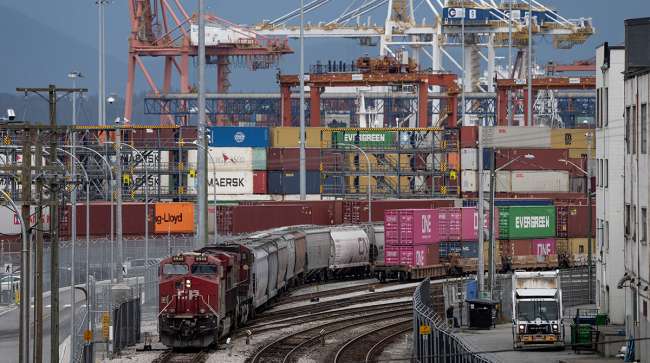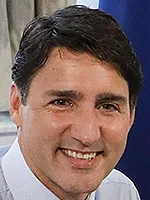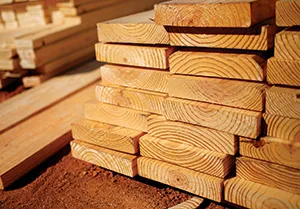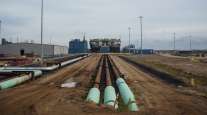Bloomberg News
Canada Braces for Economic Disruption

[Stay on top of transportation news: Get TTNews in your inbox.]
The country that buys more U.S. goods than any other and is its largest external oil supplier is bracing for economic disruption now that voters have returned Donald Trump to the White House.
Canada’s economy depends on its ability to sell energy, cars, minerals and other goods to the U.S. Its consumers and businesses also rely heavily on U.S.-made imports — from Kia Vehicles assembled in Georgia to tractors manufactured in Iowa. The two countries have one of the world’s largest bilateral trading relationships, worth about $2.6 billion in goods and services daily, similar in size to U.S.-Mexico trade flows.
Trump’s promise of across-the-board tariffs on everything the U.S. imports will rattle the entire region.
If the Republican president-elect follows through on his protectionist platform — including 60% tariffs on Chinese goods — the weight of the U.S. in global trade would come down substantially and global gross domestic product would take a hit, according to an analysis by Bloomberg Economics. Mexico and Canada would be more affected than any other countries, with GDP 2% lower by 2028 if the rest of the world retaliates against the U.S..
Prime Minister Justin Trudeau congratulates Donald Trump on his election as President of the United States of America. Read his statement: https://t.co/IdTQ8TcsLL — CanadianPM (@CanadianPM) November 6, 2024
The odds of a recession in Canada will rise, according to economists at Desjardins, a Quebec-based financial group.
There’s also a forthcoming review of the U.S.-Mexico-Canada trade agreement. Within Canada, that means governments, CEOs and industry groups will be taking another look at the playbook they used when Trump threatened to tear up the regional trade accord during his first term in office.
“We’re ready for the work of a Trump presidency,” Flavio Volpe, president of the Automotive Parts Manufacturers’ Association in Canada, said via phone. That also means trying to prepare for surprises from a president who has a history of making impulsive policy pronouncements on the fly. “I don’t think we’ll be able to predict day-by-day.”
Trump tends to focus on trade deficits, and “investors should be aware the U.S. trade deficit with Canada and Mexico has widened almost $100 billion since Trump left office,” Ian de Verteuil, a strategist at Canadian Imperial Bank of Commerce, said in a note early Nov. 6. “Trump has promised a universal 10% blanket tariff on all imports, and even with USMCA on our side there is always the possibility of future tariffs on Canadian goods under a Trump presidency.”
Canadian Prime Minister Justin Trudeau is one of only two current Group of Seven leaders who was in office for the first Trump presidency (France’s Emmanuel Macron is the other). He congratulated Trump on X.
“The friendship between Canada and the U.S. is the envy of the world,” Trudeau said. “I know President Trump and I will work together to create more opportunity, prosperity, and security for both of our nations.”
Here are some of the key Canadian sectors most affected by Trump’s trade policies.
Cars and Trucks

Trudeau
Canada exports more than 95% of vehicles it produces, and the U.S. is the dominant buyer. Tariffs are likely, but they’re not only problem for Canada. Trump’s proposal to make interest payments on car loans tax-deductible for U.S.-built vehicles, if implemented, would make Canadian-made cars less competitive.
But it’s complicated. The two countries’ auto-supply chains are highly integrated. Ford Motor Co., General Motors Co. and Chrysler parent Stellantis NV assemble cars in southern Ontario. About half of the parts for vehicles made in Canada come from the U.S., according to Volpe.
The Biden administration’s Inflation Reduction Act forced Canada’s federal and provincial governments to promise billions of dollars to automakers to lure them to build electric vehicles and their batteries in the province of Ontario. The future of that U.S. law and other policies around the adoption of electric vehicles is now in question.
Oil and Gas
Canada is by far the biggest source of imported crude for the U.S., supplying more than half of its total petroleum imports in 2022. Trump has vowed to increase U.S. drilling by opening up federal lands, rolling back regulations and offering tax breaks. Those measures may ramp U.S. energy production, possibly at the expense of Canadian products.
However, Canada now has a bigger pipeline running to the west coast — the expanded Trans Mountain line opened earlier this year — giving it greater access to non-U.S. markets.
It’s far from clear what impact, if any, a Trump administration would have on oil prices. Some analysts have warned of the potential for downward price pressure, partly because tariffs would slow global growth. But others see Trump putting the squeeze on Iran, and pro-growth economic policies in the U.S. are another factor.
It’s unlikely that Trump would put tariffs on oil and gas imports into the U.S. but he’ll likely focus more on foreign policy actions such as imposing sanctions, said Laura Lau, chief investment officer at Brompton Group.
“In terms of oil and gas production in the U.S., it’s already increasing. It increased under Biden so it’ll increase under Trump,” she said. “The only thing he can do is open up some of these restricted areas to drill. By the time you start drilling them, his term will be over.”
Metals and Lumber

The U.S. hiked import duties on Canadian softwood lumber by almost 81% in August. (Luke Sharrett — Bloomberg News )
During Trump’s first term, he imposed tariffs on Canadian and Mexican steel and aluminum — a bargaining chip during the contentious negotiations over the North American trade agreement. Canada is by far the largest exporter of aluminum to the U.S., which produces only a small fraction of what it needs of the metal. “While China floods the world, Quebec has got enough for North America,” Volpe said.
After about a year of the previous trade actions, both sides “understood that those tariffs were doing harm given the integrated nature of our economy,” said Catherine Cobden, chief executive officer of the Canadian Steel Producers Association.
“They’re in a battle against unfair trade and frankly, we’re in the same battle in Canada,” she said. “So what we have to do — and what we have been doing and we must continue — is to join them in that battle and unite with them on the fight, which is to get unfair trade out from our marketplaces.”
U.S. moves to limit the flow of Canadian softwood lumber are a point of trade friction that goes back decades. The U.S. hiked import duties on Canadian softwood lumber by almost 81% in August, the latest move in a simmering four-decade disagreement.
Consumer Goods
Want more news? Listen to today's daily briefing above or go here for more info
When Trump hit Canada with steel and aluminum tariffs in 2018, Canada responded Trump’s measures by adding tariffs to a long list of consumer products imported from the U.S. — everything from mattresses to Kentucky bourbon to washing machines.
That was a different environment: Canadian households hadn’t just gone through an inflation shock. Now they have. A tariff war stands to create new pressures on consumer prices, especially if the loonie continues to weaken against the U.S. dollar.
Banks
Some of Canada’s biggest lenders, including Bank of Montreal and Royal Bank of Canada, have large U.S. operations would benefit from corporate tax cuts. If a Trump presidency lifts the U.S. dollar, they may also see a modest benefit from their U.S.-dollar profits when they’re converted back to Canadian dollars, which they report in.
U.S. banks could see lower capital requirements if Trump wins. That could force Canada’s bank regulator to retreat, or at least slow down, the implementation of tougher capital rules.




